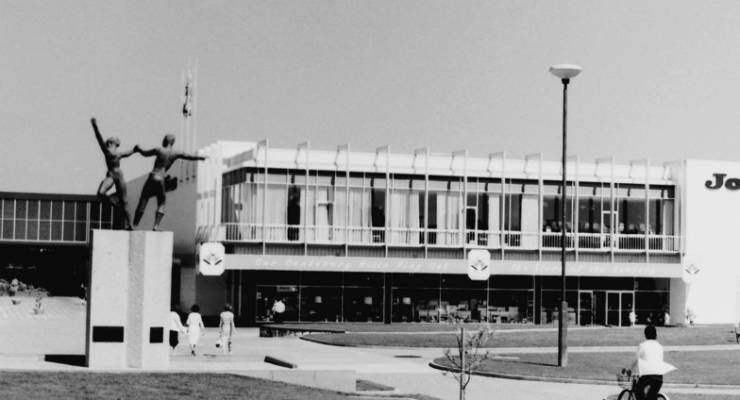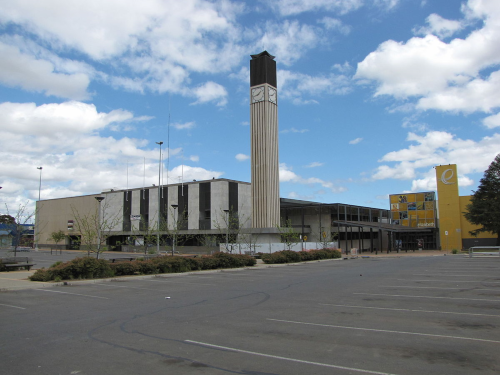
Standing before the austere modernist clock tower of Elizabeth, South Australia, Marilyn Baker, several times mayor of the city and one of its greatest champions, admonished me for the third time:
“You will write good things about us, won’t you?”
We’d spent the afternoon round and about the place, once a separate new town in its own right, now a part of northern Adelaide. We’d driven Elizabeth’s elegantly curved, eucalypt-attended roads, passed the now-shuttered Holden plant in all its vastness, inspected the bold, sculptured fountain — which had once stood at the very centre of town and was moved to the edge of the shopping mall car park — and poked around a few remaining “Elizabeth homes”; neat, vaguely stylish modernist homes built when the place was started in the 1950s.
“Journalists come up here to write the worst things.”
Still I had not been able to convince her, that I wasn’t here to do a hatchet job. Elizabeth was built as part of South Australia’s rapid industrialisation in the 1950s. Since the 1990s it has been a resource for journalists looking for stories of dole rorting, weird sex crimes or urban disaster in general.
“Not me,” I said. “I’m a believer.” It’s true too. I’d come to Elizabeth to see the Australia we never got — a place where planning, economy and administration work together to create a new society, as a population swells.
But the planned roads of Elizabeth were those not taken. After the city was planned, laid out and booming, Australia never attempted one like it again. Even by the 1970s, it was being pointed to as a way not to do urban development; by the ’80s it was a byword for bad planning — so much so that no one really questioned the judgement.
The question was, why? For 70 years we have been ramrodding the population, growing by close to 500% over the span of one long lifetime. Does it not make sense that we would build whole new cities to accommodate them? What did we do instead?
***

Elizabeth city centre today
“They said they were going to pull down the clock tower. I said I’ll be on top of it when you do. So they didn’t.”
On an early brochure, the Elizabeth clock tower stands, a tall flat carton with a plain pyramid point. It is all boldness and futurity, looming over a vast plaza of happy 1950s people, in their Sunday best. Not a shop can be seen.
The place looks clean, sleek, on the model of English “New Towns”, hopeful humanoid sculptures and all. Sleek — and a little dull. “Wasn’t it, uh, boring?” I asked Dave, a retired local butcher, town councillor, and a resident since childhood. “Ooooooooh nooooooo,” he says in his extant Northern accent — Elizabeth was designed in part to draw British immigrants — “it was every exciting. The pubs were groaning, there was a lot of music.” That’s true enough. The SA pub rock scene there produced Cold Chisel and the Angels, so …
“Surely,” I say to Marilyn, “it was tough on women, housewives? People were settling a red-dirt plain. Your mum must have had some hard times.”
“Oh no, she loved it in the end!” said Marilyn.
In the end, hmmm. By the 1970s and 1980s, the modest life it offered was starting to pall. Jimmy Barnes, its most famous son, said it was “a great place when you were young … football fields everywhere, but … around 13 or 14, it gets pretty rugged … lots of gangs, lots of street fights”.
The government began to use it purely as a welfare agency, and Elizabeth and nearby Salisbury became areas of high unemployment — and then of “problem families” moved out of other estates. The city’s reputation plummeted.
That sealed its fate. In the mid-1990s, the city centre was sold off by a cash-strapped state government, and in 1997, the municipality was folded into a mega-area, Playford. The town hall was rehoused in a postmodern shed to one side, and the centre was sold off for shopping mall development. That’s when Marilyn made her threat to occupy the clock tower.
In the council chambers, she shows me eight square metal bas-reliefs in a pattern on the walls.
“These were the door handles in the old centre. They wanted to just throw them out.” A sort of nihilism had taken over, a positive desire to trash the naïvete of earlier times. The new city centre of Elizabeth is the food court of the mall.
Naïve as it may have been, having a Henry Moore-esque fountain and figures reaching for the stars at the centre of your city, seems more aspirational than car parking for the Woolies.
We killed Elizabeth as a possibility, and then we pointed to it as an example that planning, state investment and conscious social development do not work.
Not the place’s fault. We sacrificed aspiration and audacity to endless subdivision, surrendered to sprawl. “Remember you promised to write good things!” my guide said, as she dropped me at the Woolies. I did my best, Marilyn. By the waters of Elizabeth fountain, I shed a tear for ambition sold short, what we might have been.








My Elizabeth High Year 12 class from 1977 belies many of the myths about the Northern suburbs.
http://www.footyalmanac.com.au/elizabeth-high-1977-class-12-2-am-i-ever-gonna-see-your-face-again/
Nice colour piece from Grundle – “a long time ago, in a forward thinking country far, far away..”
Meanwhile, young families commute 2-3 hours, if lucky, the inner cities reach for the skies of Shanghai & HK and shoeboxes cost a coupla mill.
It is rather difficult to compare Shanghai (or Shenzhen) with HK; much less summarise the cities. The trains in those cities are rather good; superior to the lower grade that exists in any capital city of Oz. One could get entirely across either city in (well) under two hours by (metro) train. Commuting for 40-60 minutes is normal – as it is in Oz.
Shoeboxes : well it depends. Yep – top dollar is possible but the “same” place 45 minutes away is a half to a third the price. The (average) occupancy of about 40% in Shenzhen (a bit higher in Shanghai or HK) “helps”.
However, I agree with the general tone; because there are no votes (comparatively) in the regional areas no poly gives a damn and there is a vested interest (ask any inner-city dwelling Green) to increase concentration in the cities. Myopic, as a policy, but there it is.
Very depressing. We’ll all be swallowed up by the vampiric cities of Brisbane, Sydney and Melbourne. Stuck in the Judge Dredd timeline.
Thanks Guy, for revisiting Elizabeth. This is the place where they let a girl go halfway through year 12 without a qualifying set of subjects because they didn’t believe THIS GIRL IS GOING TO UNIVERSITY! Had to pick up some subjects in a hurry. Another friend taught 3rd generation unemployed around here. That was in the 90s, long before they pulled the plug on Holden. The crying shame is that for the price of 1 stupid submarine, they could GIVE Elon Musk a factory, re-furbished and staffed with workers trained to his specification. Hell, for the price of the submarine rort the Tesla could become the Ausla…
On the one hand the topic cannot be addressed in under a few thousand words. Such being the case statements, in compensation, to the effect of “We killed Elizabeth as a possibility” BECAUSE unrestrained financial interest attained the upper-hand. Consider Kalgoorlie. The malls/shopping centres are at the lower end of town. Port Hedland wiped out its town centre about 40 years ago by permitting a shopping centre to be constructed about 3km distant from the town centre. South Hedland is “only” a Shopping Centre. As for educational “attainment”? Similarly, or anyone under the age of 11 they are great places go grow up.
Then we have the fatuous implication :” and then we pointed to it as an example that planning, state investment and conscious social development do not work” – which, in point of fact, do work but only with an organised strategic plan and political will. Considerations to “cost-cutting” will undermine everything – and defeat any laudable objective.
Then we have, from the author of the article “Not the place’s fault. We sacrificed aspiration and audacity to endless subdivision, surrendered to sprawl” – which goes some (minor) way to identifying the problem with out identifying the specifics. Then, lastly, “I shed a tear for ambition sold short, what we might have been”. Well you might Guy but your submission deserves a fail in any event. Should you wish me to expand on what ought to have been a more comprehensive article I am happy to do so.